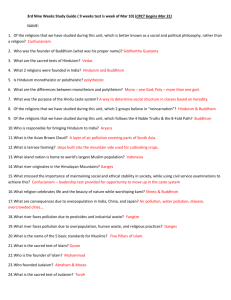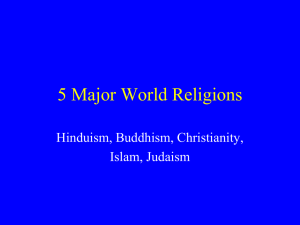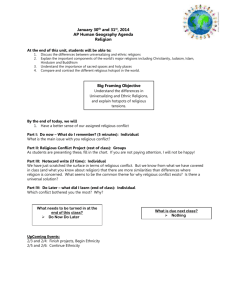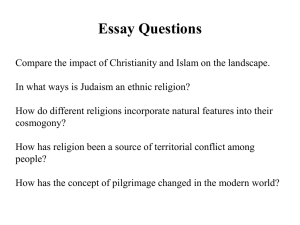Unit 3 Test
advertisement
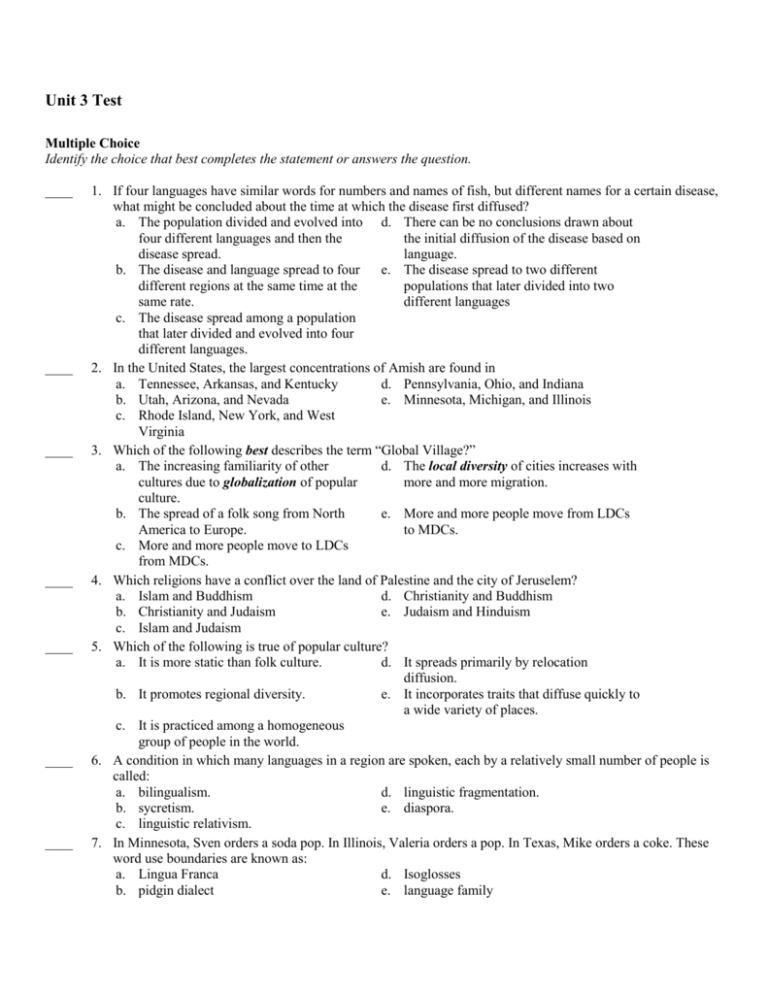
Unit 3 Test Multiple Choice Identify the choice that best completes the statement or answers the question. ____ ____ ____ ____ ____ ____ ____ 1. If four languages have similar words for numbers and names of fish, but different names for a certain disease, what might be concluded about the time at which the disease first diffused? a. The population divided and evolved into d. There can be no conclusions drawn about four different languages and then the the initial diffusion of the disease based on disease spread. language. b. The disease and language spread to four e. The disease spread to two different different regions at the same time at the populations that later divided into two same rate. different languages c. The disease spread among a population that later divided and evolved into four different languages. 2. In the United States, the largest concentrations of Amish are found in a. Tennessee, Arkansas, and Kentucky d. Pennsylvania, Ohio, and Indiana b. Utah, Arizona, and Nevada e. Minnesota, Michigan, and Illinois c. Rhode Island, New York, and West Virginia 3. Which of the following best describes the term “Global Village?” a. The increasing familiarity of other d. The local diversity of cities increases with cultures due to globalization of popular more and more migration. culture. b. The spread of a folk song from North e. More and more people move from LDCs America to Europe. to MDCs. c. More and more people move to LDCs from MDCs. 4. Which religions have a conflict over the land of Palestine and the city of Jeruselem? a. Islam and Buddhism d. Christianity and Buddhism b. Christianity and Judaism e. Judaism and Hinduism c. Islam and Judaism 5. Which of the following is true of popular culture? a. It is more static than folk culture. d. It spreads primarily by relocation diffusion. b. It promotes regional diversity. e. It incorporates traits that diffuse quickly to a wide variety of places. c. It is practiced among a homogeneous group of people in the world. 6. A condition in which many languages in a region are spoken, each by a relatively small number of people is called: a. bilingualism. d. linguistic fragmentation. b. sycretism. e. diaspora. c. linguistic relativism. 7. In Minnesota, Sven orders a soda pop. In Illinois, Valeria orders a pop. In Texas, Mike orders a coke. These word use boundaries are known as: a. Lingua Franca d. Isoglosses b. pidgin dialect e. language family ____ 8. ____ 9. ____ 10. ____ 11. ____ 12. ____ 13. ____ 14. ____ 15. ____ 16. c. Isolated Languages People in London, Melbourne, Vancouver and Mumbai all speak a. lingua francas d. different creoles b. a pidgin language e. different dialects c. official languages Which of the following originated in South Asia and subsequently spread throughout much of Southeast and East Asia? a. Christianity d. Hinduism b. Sikhism e. Confucianism c. Buddhism When European settlers established relations with Native Americans, a new language was created to ease translation for both groups. What is that language called? a. Constitutional language d. Official language b. Indigenous language e. Creole language c. Trade language A fundamental difference between folk culture and popular culture is that folk culture: a. loses some of its distinctive characteristics d. is adaptive to change over time. as it crosses national boundaries. b. tends to diffuse rapidly across space e. represents universal values. c. often sets a minority group apart from a regions general population. The world’s most widespread religion is a. Buddhism d. Hinduism b. Christianity e. Animism c. Islam Linguistic geographers use isoglosses to mark: a. the area in which an extinct language is d. the extent to which a lingua franca is used used. in a particular area. b. the area in which an official language is e. the limits for an area in which particular used. words are used. c. the creation of pidgins. What are the three main universalizing religions? a. Christianity, Catholocism, Hinduism d. Daoism, Roman Catholocism, Judaism b. Christianity, Islam, Buddhism e. Hinduism, Christianity, Judaism c. Roman Catholic, Protestant, Eastern Orthodox. Which language has become the world’s primary lingua franca? a. Spanish d. Mandarin Chinese b. German e. Hindi c. English Which of the following was not one of the earliest ancient cultural hearths? a. Nile Valley d. Mesopotamia b. Indus Valley e. Mississippi Valley c. East Asia ____ 17. ____ 18. ____ 19. ____ 20. ____ 21. ____ 22. ____ 23. The saltbox-type house pictured above originated in which of the following cultural areas? a. New England and the Canadian Maritimes d. The Canadian Prarie b. The United States’ Southwest e. The United States’ Southeast c. The Great Lakes region Acculturation is a common cause of a. assimilation d. language extinction b. creolization e. illiteracy c. cultural diffusion An European who refers to China as the “Far East” is reflecting a form of: a. humanism d. assimilation b. cultural relativism e. animism c. ethnocentrism Which of the following is an example of an ethnic religion? a. Buddhism d. Mormonism b. Roman Catholocism e. Islam c. Judaism In contrast to societies that are strongly influenced by popular, folk societies are: a. less resistant to cultural change d. more inclined to tolerate a variety of social customs and behaviors b. more likely to place a strain on natural e. more limited in their building materials resources c. less likely to promote religious values The term “Cultural Diffusion” refers to the: a. assimilation of a minority culture into the d. spread of an idea or innovation from its host society. source. b. integration of behavioral traits within a e. modifications of earth’s surface by human group. actions. c. relationship between human cultures and their physical environment. Local Native American and African religions that teach a belief in a natural world full of spiritual beings and supernatural powers are often referred to as a. shamanistic. d. local religions. ____ 24. ____ 25. ____ 26. ____ 27. ____ 28. ____ 29. ____ 30. ____ 31. ____ 32. b. animist. e. missionary. c. denominational. The modern game of soccer (football) spread to many parts of the world because of British colonization. This is an example of what type of diffusion? a. Relocation d. Expansion b. Stimulus e. Hierarchical c. Contagious Which of the following counries has the largest percentage of Roman Catholics? a. Great Britain d. the United States b. Germany e. Italy c. Greece Which of the following is true of folk culture? a. Folk and popular culture often create d. Folk culture and traditions often have artifacts for the purpose of being sold to a pinpointed dates of innovation and large number of people. creation. b. Folk culture is based on rapid e. Folk culture often comes from MDCs and simultaneous global connections through diffuses to LDCs through globalization. communication systems, transportation networks, and other modern technology. c. Folk culture often comes from anonymous sources, at unknown dates. The hearth and spiritual center of Islam is at a. Baghdad d. Mecca b. Jakarta e. Cairo c. Jerusalem Which of the following is not a Romance language? a. Romanian d. Italian b. Spanish e. French c. Austrian Which of the following was the most pronounced affect of the Norman invasion of England on the English Language? a. The Normans spoke French which became d. The Normans spoke French which the language of the lower class. combined with the more Germanic English of the Angles, Saxons, and Jutes to form a new language. b. The Normans brought the Celtic language e. The Normans brought Scandanavian to England. words which still remain in place names. c. The language of the upper class became German. To which branch of the Indo-European language family does English belong? a. Indo-Iranian d. Germanic b. Balto-Slavic e. Romance c. Indic The branch of Christianity that has the largest number of adherents is: a. Roman Catholocism d. Lutheranism b. Protestantism e. the Baptist Church c. Eastern Orthodoxy In the Canadian prairies, barns were first built with: a. fossilized shellfish cement d. plywood ____ 33. ____ 34. ____ 35. ____ 36. ____ 37. ____ 38. ____ 39. ____ 40. ____ 41. ____ 42. b. stones e. sod and thatch c. logs In the 1600s, Peter the Great returned to Russia from his travels in Europe and taught his people WesternEuropean style dance. This diffusion of Western style dance is most closely an example of: a. Theocracy d. Sequent Occupance b. Hierarchical Diffusion e. Cultural Isolation c. Contagious Diffusion What type of calandar to North Americans use? a. Drought d. Solar b. Solstice e. Agricultural c. Lunar Acculturation is a process whereby: a. the dominant culture completely absorbs d. non-material and material culture spread the less dominant one. to areas around them. b. the more dominant culture adopts most of e. the less dominant culture adopts some of the traits of the less dominant culture. the traits of the more influential one. c. cultural traits are equally exchanged between two cultures. Regionalization would best explain the characteristics of the study of a. built environment d. folk culture b. adaptive strategies e. popular culture c. material culture The two primary Eastern religions of Hinduism and Buddhism each have there hearths located where? a. Western Saudi Arabia d. Southeast Asia b. Jerusalem e. Eastern China c. Northern India Which of the following is not an ethnic religion? a. Shintoism d. Shamanism b. Hinduism e. Sikhism c. Judaism Swahili in East Africa and English in global commerce are examples of: a. lingua franca. d. pidgin languages. b. creole language. e. standard leagues. c. official language. Which of the following is the largest proselytizing religion? a. Islam d. Christianity b. Buddhism e. Hinduism c. Shintoism Throughout history, numerous colonial powers have argued that certain types of people, living in certain areas of the world, are less able to govern themselves because of the qualities they have developed due to their interactions with natural factors, such as climate. This belief is an example of: a. possibilism d. ecumenism b. cultural ecology e. environmental determinism c. positivism Cultural ecology studies the a. interactions between places over time d. interactions between human societies and the physical environment b. relationship between media and diffusion e. relationship between politics and policy ____ 43. ____ 44. ____ 45. ____ 46. ____ 47. ____ 48. ____ 49. ____ 50. ____ 51. c. relationship between language and land use Yom Kippur, or the Day of Atonement, is the most important holiday in which religion? a. Islam d. Hinduism b. Judaism e. Christianity c. Buddhism A trade language is called a a. syncretic. d. Creole. b. dialect. e. pidgin. c. lingua franca. Which of the following is not an explanation of the widespread use of English? a. 50 countries have English as an official d. U.S. imperialism after the Spanish language. American war. b. Its ease of learning. e. English control over south Asia and Africa during the 18th and 19th centuries c. Colonization of and immigration to the United States during the 17th century The Kurgan hearth theory explains: a. the creolization of Enlgish. d. the diffusion of Indo-European language. b. a hierarchical diffusion of popular culture e. the differences between English in the words such as “computer.” United States and England. c. the development of regional dialects. Which of the following is not a place name in the United States that reflects geographical origins? a. Germantown, PA d. New York b. New Hampshire e. Pottstown c. New Jersey ______________ is an excellent example of a nonevangelical univeralizing religion. a. Buddhism d. Hinduism b. Polytheism e. Protestantism c. Christianity American English differs from English in England because: a. Most immigrants to the United States were d. The United States passed a law in 1820 from the upper class of England. making English its official language. b. English in the United States has changed e. Americans consciously changed the more than English in England language to distinguish themselves from Great Britain after the American Revolution. c. The language has grown apart because the two countries were isolated from each other. The earth’s heterogeneous collection of languages is an example of: a. cultural diversity d. hierarchical diffusion b. ethnic conflict e. demographic transition c. globalization The field that studies the relationship between the natrual environment and culture is called: a. cultural diffusion d. environmental determinism b. syncretism e. cultural geography c. linguistic geography ____ 52. As Islam spread to Sub-Saharan Africa, its first converts were the elites, but most ordinary people retained their native religions. This phenomenon illustrates the process of: a. migrant diffusion d. stimulation diffusion b. relocation diffusion e. contagious diffusion c. hierarchical diffusion ____ 53. The world’s three major monotheistic religions originated in which of the following regions? a. Eastern Europe d. Sub-Saharan Africa b. East Asia e. Southwest Asia c. Western Europe ____ 54. Which of the following is true in terms of the culture of most sports? a. The most popular sports in the world d. Most popular sports start out as folk began simultaneously in many different culture before diffusing around the world cultural hearths. to the point at which people are willing to pay professional athletes. b. Sports start out as popular culture before e. Sports tend to spread around the world being adapted by people in different more slowly than other forms of popular regions to folk culture. culture. c. Sports rarely diffuse outside of their cultural hearth. ____ 55. Literacy rates vary by a. sex. d. location. b. economic development. e. all of the above. c. education. ____ 56. The most widespread language family on earth is the a. Romance d. Sino-Tibetan b. Indo-European e. Germanic c. Mandarin Chinese ____ 57. When Muslims make he pilgramage to Mecca to observe the Kabah, which of the five pillars are they practicing? a. Hajj d. Salah b. Sawm e. Zakat c. Shahadah ____ 58. The Indo-European language family has its distant origins in the area around the: a. Baltic Sea d. Black Sea b. Arabian Penisula e. Italian Peninsula c. Iberian Peninsula ____ 59. Many Islamic states in the Middle East region combine religion and state and don’t separate them. This is an example of what? a. Plural society d. Multilingual society b. Theocracy e. Democracy c. Monotheism ____ 60. Which of the following is a dialect? a. Indo-European d. Romance b. Latin e. southern United States c. Dravidian ____ 61. The process by which one generation passes culture to the next is called: a. cultural relativism. d. assimilation. b. syncretism. e. cultural transmission. c. cultural diffusion. ____ 62. Which of the following is an example of a cultural landscape? a. a stand of pine trees d. a coral reef b. tropical jungle e. terraced fields of crops up a mountainside c. a glacier ____ 63. Cultural geography is the study of a. cultural complexes. d. human-environment relationships. b. the spatial distribution of cultural traits. e. how cultures change through time. c. global customs and artifacts. ____ 64. Wooden shoes characteristic of the Dutch culture are an example of a(n) a. syncretism. d. artifact. b. mentifact. e. custom. c. complex. ____ 65. What is the largest ethnic religion? a. Confucianism d. Hinduism b. Daoism e. Shitoism c. Judaism ____ 66. Which of the following schools of thought puts most emphasis on the importance of the physical environment in shaping culture? a. environmental perception d. possibilism b. cultural ecology e. cultural determinism c. environmental determinism ____ 67. What language is known as the lingua franca of Eastern Africa? a. Hindi d. Swahili b. French e. English c. Zulu ____ 68. The type of culture that includes a wide range of artifacts is called: a. non-material culture d. popular culture b. folk culture e. material culture c. a culture region ____ 69. Which of the following correctly sequences the continuum from language family to dialect? a. Indo-European, Indo-Iranian, Hindi, d. Indo-European, Germanic, English, Bengali Midland-Northern b. Indo-European, Baltic-Slavic, Russian, e. Afro-Asiatic, Semitic, Arabic, Berber Ukranian c. Sino-Tibetan, Sinitic, Madarin, Chineses ____ 70. The cultural hearth of Christianity is in a. Turkey d. South Carolina b. New York e. Israel c. Rome ____ 71. All evangelical religions are also a. local religions d. universal religions b. animist religions e. polytheistic religions c. ethnic religions ____ 72. Globalization has encouraged the diffusion of: a. popular culture d. ethnic regions b. folk culture e. linguistic fragmentation c. ethnocentrism ____ 73. Culture complexes are made up of many culture: a. dialects d. regions b. hearths e. systems c. traits ____ 74. Which of the following is a particular form of relocation diffusion in which the spread of culture traits is slow enough that they weaken in the area of origin by the time they reach other areas? a. migrant diffusion d. contagious diffusion b. stimulus diffusion e. hierarchical diffusion c. expansion diffusion ____ 75. The above structure would most likely be found in which country? a. Thailand d. India b. Ecuador e. Germany c. Israel ____ 76. A world map of hog production per capita would reveal the lowest values in which of the following regions? a. The Middle East d. The United States Midwest b. Western Europe e. China c. Southeast Asia ____ 77. Mahayana, Therevada, and Tantrayana are three branches of: a. Daoism d. Hinduism b. Sikhism e. Buddhism c. Islam ____ 78. Which of the following best exemplifies folk culture? a. The purchasing of rap music by white d. Cajun music suburban youth b. A dialect that is similar in two different e. Eating Chinese food in New York City regions of the country ____ 79. ____ 80. ____ 81. ____ 82. ____ 83. ____ 84. ____ 85. ____ 86. ____ 87. ____ 88. ____ 89. c. The burial of the dead A good example of a monolingual country would be a. South Africa. d. Japan. b. Canada. e. Switzerland. c. Turkey. Which of the following is the most widely spoken, first language, language family? a. Indo-European d. Indo-Asia b. Romance e. Eastern Slavic c. Creole In _______________ religions, community, common history, and social relations are inextricably intertwined with spiritual beliefs. a. evangelical d. local b. ethnic e. monotheistic c. universal Which of the following best describes a dialect? a. a language spoken by less than 1 million d. a new language formed after one group of people. speakers looses contact with another group of speakers. b. languages spoken by more than 1 million e. languages that are from the same language people. family c. a regional variation of a language Which distinctive cultural region in the United States has its own food, music, and language along the border with Mexico? a. Swedish-American d. Creole b. Tex-Mex e. Italian-American c. Cajun Toponymy is the study of: a. place names d. religious groups b. dialects e. linguistic fragmentation c. extinct languages Haitian is an example of a(n): a. taboo. d. language branch. b. dialect. e. language family. c. creole. A country in which a majority of the population is Shiite Muslims is a. Iran d. Saudi Arabia b. Egypt e. Morocco c. Indonesia Which of the following is the best example of folk food? a. KFC in China d. Pizza in the United States b. Blowfish in Japan e. Hamburgers in the United States c. McDonald’s french fries in Germany Which of the following religions is the best example of a polytheistic religion? a. Islam d. Christianity b. Judaism e. Atheism c. Shintoism Romance languages are all derived from: a. Norman d. Latin b. Scandanavian e. German c. Iranian ____ 90. Where in the United States does Roman Catholocism dominate? a. southern New England d. Southeast b. Southwest e. A and B only c. Pacific Northwest ____ 91. Which two universalizing religions have their root in Judaism? a. Christianity and Islam d. Hinduism and Islam b. Christianity and Buddhism e. Daoism and Christianity c. Daoism and Islam ____ 92. What is a denomination? a. A large and fundamental difference d. an individual who founds a religion and between religions. helps to diffuse it across the globe. b. a small seed covering e. a small group that has broken away from an established religion c. A division or branch that unites a number of local congregations into a single administrative body. ____ 93. Cultural traditions, such as Christmas, are ____________ since they borrow from the past and are continually reinvented in the present. a. erratic d. inauthentic b. ecumenical e. complex c. sycretic ____ 94. ____ 95. ____ 96. ____ 97. ____ 98. The statue above is an important symbol for adherents of: a. Easter Orthodoxy d. Buddhism b. Hinduism e. Confucianism c. Islam Which ethnic religion is distributed across the United States, Israel, Europe, Asia and Africa? a. Islam d. Hinduism b. Daoism e. Christianity c. Judaism The literal interpretation of and strict adherance to principals of a religion is known as: a. an autonomous religion. d. religious values. b. religious fundamentalism. e. a denomination. c. a crusade. Which of the following areas has the greatest linguistic fragmentation? a. Argentina d. Scandinavia b. Quebec e. Korea c. Caucasus A pilgrim to Varanasi (Benares) in India is most likely to be a: a. Muslim d. Buddhist b. Hindu e. Christian c. Jew


